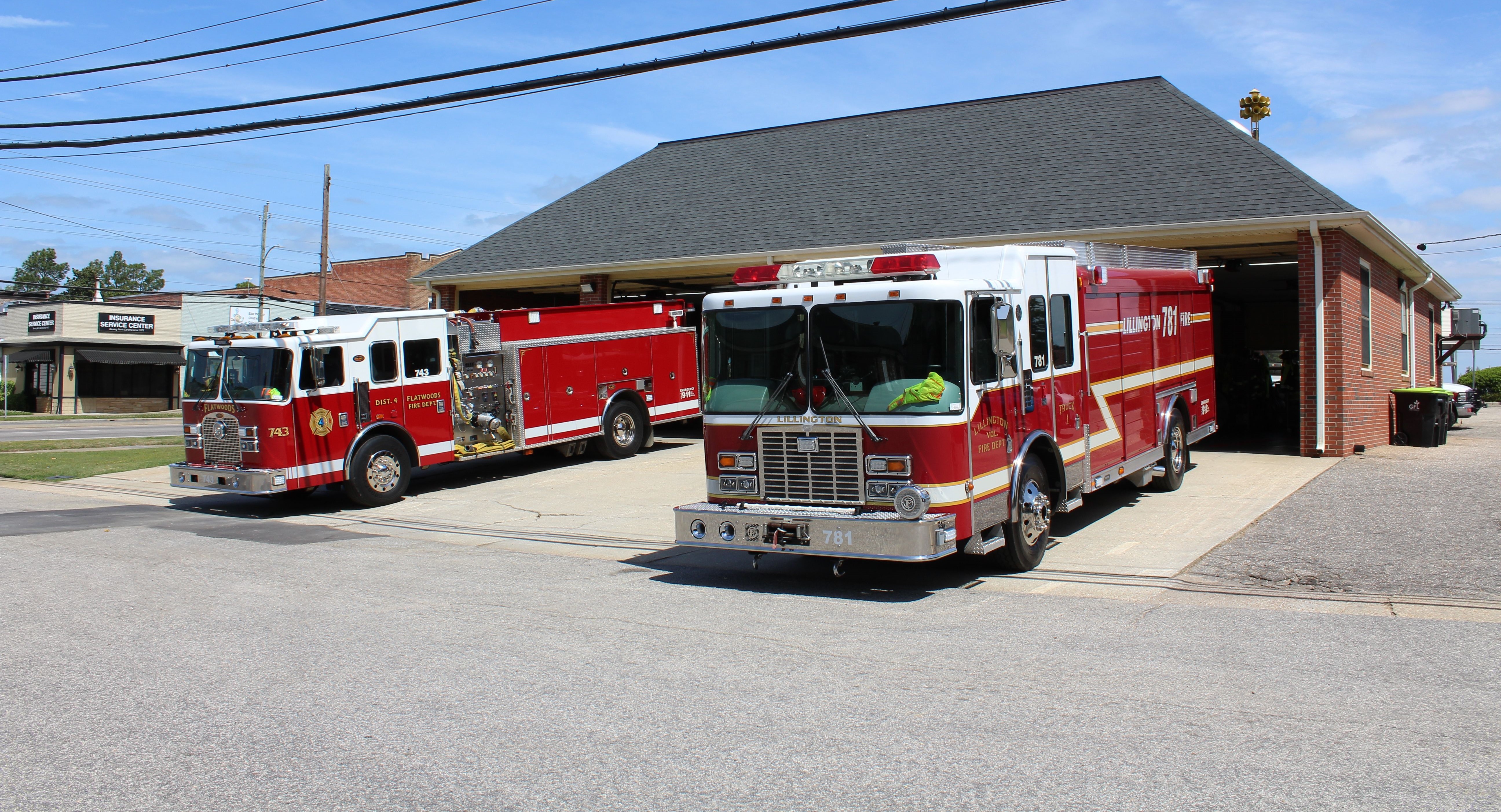History

The Town of Lillington Fire Department’s long history began in the early 1900’s with a loosely organized “bucket brigade” made up of town citizens. The first mention of fire protection in the town minutes was in 1909 when the primary fire district and committee were created to inspect and govern the construction of buildings in the downtown area. A hand pulled hose reel, 1000 feet of hose, and nozzles were purchased by the town in 1916 to be used in conjunction with the new water system recently installed. The new water system used a series of wells, elevated water tank and pumps to supply water to the residents and hydrants. In December 1916, the General manager Thomas Reynolds (Reynolds was hired to serve as the fire chief, police chief, town clerk, and tax collector) reported to the board that when equipment arrived, he would, “organize a volunteer department, instruct and drill with the latest methods”. The hose and reel were purchased from the Eureka Hose Company and valued at $741.75 in 1917.
Around 1920, the Town purchased its first motorized fire apparatus for $1,000.00. The new fire truck was a Ford chemical and hose car, which used one or two large, mounted extinguishers for a quick-fire attack. Space at the Atkins Brothers garage located on 8th Street was rented for storage of the fire truck and hose reel at a rate of $5.00 per month. In April of 1922, L.K. Matthews was elected to serve as the fire chief and was ordered to “respond for duty”, Matthews was given a salary of $5.00 a month to carry out his duties. In 1924 the town voted to pay its volunteers $1.00 per call where “water was thrown”. A fire occurring in December of 1924 showed that 11 members attended and were paid by the town secretary. In January of 1924 the members (18) of the department joined the N.C. State Fireman’s Association, which provided insurance and training sessions at annual conventions. Fire department members took advantage of the training and numerous notations are made showing representatives attending conferences across the state.

Chief Matthews appears numerous times before the town board requesting an additional hose and another reel and an electric fire siren be installed to call volunteers for calls. Matthews requested that a fire station also be built that year, but he would not see the station built until 1933. Unlike the computerized enhanced 911 system that we have now, the receiving and dispatching of fires were haphazard at best. During the 1920’s, if someone needed the fire department they would call the front desk of the Lillington Hotel, which was located beside the current fire station. The clerk working would take the call, go outside to the fire alarm switch, set the siren off, then the first volunteer to arrive would go to the hotel and see where the fire was. The number of fires in Lillington and surrounding area only numbered 3 or 4 a year according to our records. The Lillington Fire Department responded to calls outside the city limits since there were no rural fire departments during these early years.
In 1928 the fire department purchased a type 99 American LaFrance 500 g.p.m. pumper. The truck was built in Elmira, New York, and was delivered via flatbed railroad car to Lillington after being featured at the National Fire Chiefs convention. Number 1, as it’s commonly called, cost the town $6,500.00 and $500.00 cash value was allowed on the old Ford fire truck. The truck featured an 80-gallon water tank designed to be filled with buckets outside the area where hydrants existed. The Town still owns this truck and restored it about a decade ago.
In 1933, using funds donated by Mr. L.D. Burwell, a state of the art fire/police station and town hall was built on Main Street and is still in use. Two bays were built within the station to house the pumper, hose reel, and various other equipment. In the same year, the board enacted an ordinance prohibiting anyone who was not a fireman from riding the truck to a fire. This was considered a misdemeanor and punishable by a $5.00 fine.
Little records exist for the first few years, though the Salmon house fire of 1948 is documented (this large 2-story house was where the B.B.&T. bank now sits). In 1954 the fire department, under the direction of Chief W.P. Sutton, fought the teacherage house fire, the bottom floor of which is still in use and is beside the Lillington Middle School. An interesting story that took place during these years was: as the truck pulled on the street to respond to a call, the old truck hit a dip in the road; one of the firemen riding on the back wasn’t holding on very well, he fell off, and the Town police car ran over the top of him. The firemen stopped in the middle of the street, retrieved the injured fireman, threw him in the back of the truck and continued on to the fire. In 1960, the department responded to a mobile home fire that claimed the life of a two-year-old, and a fire at the Lillington Ice Plant.

In the year 1961, the town purchased a Ford/Seagrave 750 g.p.m. pumper. This pumper is still used as a reserve engine today. In 1968 the Town decided to stop answering calls outside of the city limits and the Summerville Rural Fire Department was formed. In the early 70’s, the department responded to the Mack’s Variety Store and Piggly Wiggly Store fires on Front Street. In 1976 the town built a new fire station and purchased a 1976 Ford cab over 1000 g.p.m. pumper. The members of the department sponsored turkey shoots to raise money and put on firework shows at the annual Fourth of July celebration in Lillington, now one of the largest Fourth celebrations in the Piedmont.
In 1989 the fire department ran a total of 51 calls and averaged over 140 hours of training per man, four times the national average. In 1990 the town hired John Bethune, a volunteer with the department, to serve as paid daytime captain. Bethune was charged with filing reports, maintenance of vehicles and the town’s hydrants. In 1992 the department, after several years of work, lowered the town’s insurance rating from an 8 to a 5. The lower rating saves home and business owners in Lillington over $100,000.00 in insurance premiums. Also in 1992, under Chief Dan Denning, the department took on an extra role of emergency medical responders, providing advanced first aid and c.p.r. prior to the arrival of an ambulance. After going first responder, our call volume went from less than 100 per year to well over 600 per year. Some of the larger fires the department responded to in the early 90’s were the Byrd’s Food Store in Lillington and the Lafayette School fire.
In the early 2000’s, the department had 20 dedicated volunteers, 2 full-time and one part-time firefighter. The department raised over $22,000.00 for the 9/11 relief efforts, participated in the Relay for Life cancer drive and has helped raise money and distribute supplies during numerous disasters.

The department has grown to a combination department consisting of 24-hour paid staff, daytime part-timers, and 10 volunteers. We currently operate out of 2 stations protecting the Flatwoods Fire District and the Town of Lillington. Our insurance rating is a 3 and we respond to a variety of fire, rescue, water, and medical emergencies. The department currently runs 850 calls for service per year. The members of the fire department are continuously working on maintaining our insurance rating and providing the best available response to our citizens.
Our response apparatus is as follows: 5 engine/tankers, one heavy rescue, one brush truck, 2 boats, a 1961 and a 1965 parade engine, and the pride of the department- a 1928 American LaFrance Pumper, purchased new and restored 10 years ago.
We value and are trying to preserve our department’s past and still expand to meet our growing town’s needs.
Fire Chief
J.B./k.c.
